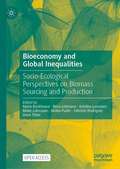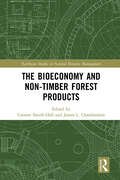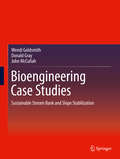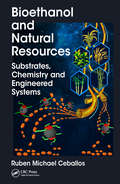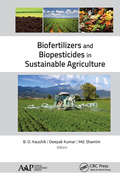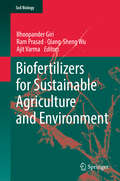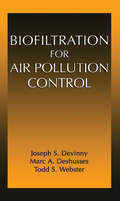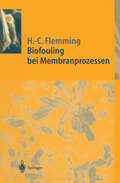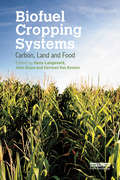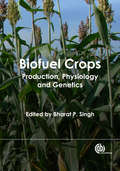- Table View
- List View
The Bioeconomy: Institutions, Innovation and Sustainability (Routledge Studies in Ecological Economics)
by Nicolas BefortThe bioeconomy is steadily becoming more important in regional, national and European public policies. As it encompasses the transformation of agricultural, marine and organic resources into food, feed, fuels, energy and materials, the bioeconomy should become a major new industry, outlining the possibility of a post-fossil future. This book is the first attempt to depict the origins, formation and challenges of this new industry in terms of emerging institutions, innovation, and economic strategies. The result of this work is that the substitution of raw materials alone is not enough to get out of the fossil economy. This book develops a political economy of the ecological transition which theorizes the transition as a new crisis of capitalism. This phase is characterized by stakeholders’ attempts to develop renewed rationales and strategies to take control of the reorganization of flows of natural resources, their outcomes and their evaluation. The proposed framework considers recent results in four complementary research strands: transition studies, institutional economics, ecological economics, and the evolutionary economics of innovation. The book will be of interest to researchers interested in the development of the bioeconomy, and both researchers and students seeking to understand the role of heterodox economics in the ecological transition.
The Bioeconomy: Institutions, Innovation and Sustainability (Routledge Studies in Ecological Economics)
by Nicolas BefortThe bioeconomy is steadily becoming more important in regional, national and European public policies. As it encompasses the transformation of agricultural, marine and organic resources into food, feed, fuels, energy and materials, the bioeconomy should become a major new industry, outlining the possibility of a post-fossil future. This book is the first attempt to depict the origins, formation and challenges of this new industry in terms of emerging institutions, innovation, and economic strategies. The result of this work is that the substitution of raw materials alone is not enough to get out of the fossil economy. This book develops a political economy of the ecological transition which theorizes the transition as a new crisis of capitalism. This phase is characterized by stakeholders’ attempts to develop renewed rationales and strategies to take control of the reorganization of flows of natural resources, their outcomes and their evaluation. The proposed framework considers recent results in four complementary research strands: transition studies, institutional economics, ecological economics, and the evolutionary economics of innovation. The book will be of interest to researchers interested in the development of the bioeconomy, and both researchers and students seeking to understand the role of heterodox economics in the ecological transition.
Bioeconomy and Global Inequalities: Socio-Ecological Perspectives on Biomass Sourcing and Production
by Maria Backhouse Rosa Lehmann Kristina Lorenzen Malte Lühmann Janina Puder Fabricio Rodríguez Anne TittorThis open access book focuses on the meanings, agendas, as well as the local and global implications of bioeconomy and bioenergy policies in and across South America, Asia and Europe. It explores how a transition away from a fossil and towards a bio-based economic order alters, reinforces and challenges socio-ecological inequalities. The volume presents a historically informed and empirically rich discussion of bioeconomy developments with a particular focus on bio-based energy. A series of conceptual discussions and case studies with a multidisciplinary background in the social sciences illuminate how the deployment of biomass sources from the agricultural and forestry sectors affect societal changes concerning knowledge production, land and labour relations, political participation and international trade. How can a global perspective on socio-ecological inequalities contribute to a complex and critical understanding of bioeconomy? Who participates in the negotiation of specific bioeconomy policies and who does not? Who determines the agenda? To what extent does the bioeconomy affect existing socio-ecological inequalities in rural areas? What are the implications of the bioeconomy for existing relations of extraction and inequalities across regions? The volume is an invitation to reflect upon these questions and more, at a time when the need for an ecological and socially just transition away from a carbon intensive economy is becoming increasingly pressing.
The bioeconomy and non-timber forest products (Earthscan Studies in Natural Resource Management)
by Carsten Smith-Hall James ChamberlainThis book provides the first in-depth investigation of how non-timber forest products are an integral part of local, national, and global bioeconomies. While the plants and fungi that produce non-timber forest products are essential to the sustainability of forest ecosystems, peoples' food and livelihood security and sovereignty, and thus the bioeconomy, are often absent from bioeconomic strategies. Presenting a selection of empirical cases from around the world that engage with the bioeconomy and non-timber forest products, this volume reveals how essential these products are to creating a greener and more sustainable future, how to to better integrate them into efforts to transition to and expand the bioeconomy, and how such efforts can be supported and developed. Chapters analyse how and to what degree non-timber forest products promote sustainable resource use, generate employment, and contribute to food and livelihood security and poverty alleviation. The volume develops approaches and identifies interventions and policies to support the integration of non-timber forest products into bioeconomy strategies, including in national reporting schemes to provide recommendations for future research and practical implementation. This book will be of great interest to students and scholars of forest and natural resource management, bioeconomics, circular economy and ecological economics more widely. It will also be of interest to professionals working in sustainable development and the forestry sector.
The bioeconomy and non-timber forest products (Earthscan Studies in Natural Resource Management)
by Carsten Smith-Hall James L. ChamberlainThis book provides the first in-depth investigation of how non-timber forest products are an integral part of local, national, and global bioeconomies. While the plants and fungi that produce non-timber forest products are essential to the sustainability of forest ecosystems, peoples' food and livelihood security and sovereignty, and thus the bioeconomy, are often absent from bioeconomic strategies. Presenting a selection of empirical cases from around the world that engage with the bioeconomy and non-timber forest products, this volume reveals how essential these products are to creating a greener and more sustainable future, how to to better integrate them into efforts to transition to and expand the bioeconomy, and how such efforts can be supported and developed. Chapters analyse how and to what degree non-timber forest products promote sustainable resource use, generate employment, and contribute to food and livelihood security and poverty alleviation. The volume develops approaches and identifies interventions and policies to support the integration of non-timber forest products into bioeconomy strategies, including in national reporting schemes to provide recommendations for future research and practical implementation. This book will be of great interest to students and scholars of forest and natural resource management, bioeconomics, circular economy and ecological economics more widely. It will also be of interest to professionals working in sustainable development and the forestry sector.
Bioenergy and Biological Invasions: Ecological, Agronomic and Policy Perspectives on Minimizing Risk
by Phang Siew Moi Caroline E Ridley Carol Mallory-Smith Larissa Smith Bryan Endres Russell Jessup Stephen F Enloe Rachel Bethke Lloyd NackleyDespite major international investment in biofuels, the invasive risks associated with these crops are still unknown. A cohesive state-of-the-art review of the invasive potential of bioenergy crops, this book covers the identified risks of invasion, distributions of key crops and policy and management issues. Including a section on developing predictive models, this book also assesses the potential societal impact of bioenergy crops and how to mitigate invasive risks.
Bioenergy and Land Use Change: Impact On Natural Capital And Ecosystem Services (Geophysical Monograph Series #231)
by Zhangcai Qin Umakant Mishra Astley HastingsAlthough bioenergy is a renewable energy source, it is not without impact on the environment. Both the cultivation of crops specifically for use as biofuels and the use of agricultural byproducts to generate energy changes the landscape, affects ecosystems, and impacts the climate. Bioenergy and Land Use Change focuses on regional and global assessments of land use change related to bioenergy and the environmental impacts. This interdisciplinary volume provides both high level reviews and in-depth analyses on specific topics. Volume highlights include: Land use change concepts, economics, and modeling Relationships between bioenergy and land use change Impacts on soil carbon, soil health, water quality, and the hydrologic cycle Impacts on natural capital and ecosystem services Effects of bioenergy on direct and indirect greenhouse gas emissions Biogeochemical and biogeophysical climate regulation Uncertainties and challenges associated with land use change quantification and environmental impact assessments Bioenergy and Land Use Change is a valuable resource for professionals, researchers, and graduate students from a wide variety of fields including energy, economics, ecology, geography, agricultural science, geoscience, and environmental science. Read an interview with the editors to find out more:https://eos.org/editors-vox/bioenergys-impacts-on-the-landscape
Bioenergy and Land Use Change (Geophysical Monograph Series #231)
by Qin Zhangcai Mishra Umakant Hastings AstleyAlthough bioenergy is a renewable energy source, it is not without impact on the environment. Both the cultivation of crops specifically for use as biofuels and the use of agricultural byproducts to generate energy changes the landscape, affects ecosystems, and impacts the climate. Bioenergy and Land Use Change focuses on regional and global assessments of land use change related to bioenergy and the environmental impacts. This interdisciplinary volume provides both high level reviews and in-depth analyses on specific topics. Volume highlights include: Land use change concepts, economics, and modeling Relationships between bioenergy and land use change Impacts on soil carbon, soil health, water quality, and the hydrologic cycle Impacts on natural capital and ecosystem services Effects of bioenergy on direct and indirect greenhouse gas emissions Biogeochemical and biogeophysical climate regulation Uncertainties and challenges associated with land use change quantification and environmental impact assessments Bioenergy and Land Use Change is a valuable resource for professionals, researchers, and graduate students from a wide variety of fields including energy, economics, ecology, geography, agricultural science, geoscience, and environmental science. Read an interview with the editors to find out more:https://eos.org/editors-vox/bioenergys-impacts-on-the-landscape
Bioenergy for Sustainable Development and International Competitiveness: The Role of Sugar Cane in Africa
by Francis X. Johnson Vikram SeebaluckGrowing concerns about the impacts of climate change and dependence on fossil fuels have intensified interest in bioenergy from sugar cane and other crops, highlighting important links between energy, environment and development goals. Sub-Saharan Africa is characterized by severe poverty; the possibility to exploit a renewable energy resource offers valuable avenues for sustainable development and could support a more dynamic and competitive economy. This book describes how the bioenergy expansion will improve rural livelihoods, reduce costly energy imports, reduce GHG emissions, and offer new development paths. Drawing on international experience, it is shown that harnessing this potential will require significant increases in investment, technology transfer, and international cooperation. Because of its high efficiency, the authors argue that sugar cane should be viewed as a global resource for sustainable development and should command much greater focus and concerted policy action. Through an analysis of the agronomy, land suitability and industrial processing of sugar cane and its co-products, along with an assessment of the energy, economic and environmental implications, this volume demonstrates that sugar cane offers a competitive and environmentally beneficial resource for Africa's economic development and energy security. With forty-four authors representing thirty organisations in sixteen countries, the book offers a truly international and interdisciplinary perspective by combining technical and economic principles with social, political and environmental assessment and policy analysis.
Bioenergy for Sustainable Development and International Competitiveness: The Role of Sugar Cane in Africa
by Francis X. Johnson Vikram SeebaluckGrowing concerns about the impacts of climate change and dependence on fossil fuels have intensified interest in bioenergy from sugar cane and other crops, highlighting important links between energy, environment and development goals. Sub-Saharan Africa is characterized by severe poverty; the possibility to exploit a renewable energy resource offers valuable avenues for sustainable development and could support a more dynamic and competitive economy. This book describes how the bioenergy expansion will improve rural livelihoods, reduce costly energy imports, reduce GHG emissions, and offer new development paths. Drawing on international experience, it is shown that harnessing this potential will require significant increases in investment, technology transfer, and international cooperation. Because of its high efficiency, the authors argue that sugar cane should be viewed as a global resource for sustainable development and should command much greater focus and concerted policy action. Through an analysis of the agronomy, land suitability and industrial processing of sugar cane and its co-products, along with an assessment of the energy, economic and environmental implications, this volume demonstrates that sugar cane offers a competitive and environmentally beneficial resource for Africa's economic development and energy security. With forty-four authors representing thirty organisations in sixteen countries, the book offers a truly international and interdisciplinary perspective by combining technical and economic principles with social, political and environmental assessment and policy analysis.
Bioengineering Case Studies: Sustainable Stream Bank and Slope Stabilization
by Wendi Goldsmith Donald Gray John McCullah"Bio-Stabilization Case Studies: Treatment and Performance Evaluation" describes and evaluates 30 projects from across the United States where bio-stabilization was employed to address a detrimental naturally occurring process or byproduct of the built environment. Bio-stabilization (or soil bioengineering) refers to the use of plant materials, primarily live cuttings, arranged in the ground in different arrays to reinforce soils and protect upland slopes and/or stream banks against surficial erosion and shallow slope failures. Examples included in the collection represent different regions of the country and their specific conditions and challenges. Each project is illustrated with a number of distinctive photographs to support the reader's understanding and showcase the wide scope of projects and techniques presented. The volume is ideal for civil and environmental engineers and environmental scientists working on watershed, infrastructure projects, and municipal scale installations.
Bioethanol and Natural Resources: Substrates, Chemistry and Engineered Systems
by Ruben Michael CeballosBioethanol and Natural Resources: Substrates, Chemistry and Engineered Systems provides a comprehensive review of feedstocks, physiochemical and biological pretreatments, molecular substrates, cellulolytic and ligninolytic enzymes, and advanced technologies for producing bioethanol. Although this book provides a review of first-generation bioethanol feedstocks, chemistry, and processes, there is an emphasis on second-generation "cellulosic" ethanol production. With rapid advances in biofuels technologies and the continued global dependency on unsustainable extraction of fossil fuels, this text is timely. Although it is intended to be used as a supplemental text for advanced undergraduate or graduate level courses, the book is accessible to a non-academic audience. This book provides a unique opportunity to understand bioethanol production from the basic concepts and processes to the most cutting-edge technologies under development.
Bioethanol and Natural Resources: Substrates, Chemistry and Engineered Systems
by Ruben Michael CeballosBioethanol and Natural Resources: Substrates, Chemistry and Engineered Systems provides a comprehensive review of feedstocks, physiochemical and biological pretreatments, molecular substrates, cellulolytic and ligninolytic enzymes, and advanced technologies for producing bioethanol. Although this book provides a review of first-generation bioethanol feedstocks, chemistry, and processes, there is an emphasis on second-generation "cellulosic" ethanol production. With rapid advances in biofuels technologies and the continued global dependency on unsustainable extraction of fossil fuels, this text is timely. Although it is intended to be used as a supplemental text for advanced undergraduate or graduate level courses, the book is accessible to a non-academic audience. This book provides a unique opportunity to understand bioethanol production from the basic concepts and processes to the most cutting-edge technologies under development.
Biofertilizers and Biopesticides in Sustainable Agriculture
by B. D. Kaushik Deepak Kumar ShamimThis new volume, Biofertilizers and Biopesticides in Sustainable Agriculture, presents strategies for the management of soil and crop diseases. Microbes have attracted worldwide attention due to their role in disease management and remediation of polluted soils. Taking a sustainable approach, this book explores the means of integrating various microbial management approaches to achieve the desired levels of crop yield under both conventional soils and neglected soils through the use of biopesticides and other botanicals as well as biomolecules. This book also presents a broad and updated view of molecular nitrogen fixation and phosphate-solubilizing and sulfur-transforming microbes for nutrition of crops in relation to the role of metal tolerant microbes in providing protection to plants grown in metal-contaminated soils. The preparation and application of biofertilizers, utilization of household waste materials, and use of genetically modified microorganisms (GMOs) in plant growth and development are also well discussed in the volume.
Biofertilizers and Biopesticides in Sustainable Agriculture
by B. D. Kaushik Deepak Kumar ShamimThis new volume, Biofertilizers and Biopesticides in Sustainable Agriculture, presents strategies for the management of soil and crop diseases. Microbes have attracted worldwide attention due to their role in disease management and remediation of polluted soils. Taking a sustainable approach, this book explores the means of integrating various microbial management approaches to achieve the desired levels of crop yield under both conventional soils and neglected soils through the use of biopesticides and other botanicals as well as biomolecules. This book also presents a broad and updated view of molecular nitrogen fixation and phosphate-solubilizing and sulfur-transforming microbes for nutrition of crops in relation to the role of metal tolerant microbes in providing protection to plants grown in metal-contaminated soils. The preparation and application of biofertilizers, utilization of household waste materials, and use of genetically modified microorganisms (GMOs) in plant growth and development are also well discussed in the volume.
Biofertilizers for Sustainable Agriculture and Environment (Soil Biology #55)
by Bhoopander Giri Ram Prasad Qiang-Sheng Wu Ajit VarmaThis book provides a comprehensive overview of the benefits of biofertilizers as an alternative to chemical fertilizers and pesticides.Agricultural production has increased massively over the last century due to increased use of chemical fertilizers and pesticides, but these gains have come at a price. The chemicals are not only expensive; they also reduce microbial activity in agricultural soils and accumulate in the food chain, with potentially harmful effects for humans. Accordingly, it is high time to explore alternatives and to find solutions to overcome our increasing dependence on these chemicals.Biofertilizers, which consist of plant remains, organic matter and microorganisms, might offer an alternative. They are natural, organic, biodegradable, eco-friendly and cost-effective. Further, the microbes present in the biofertilizers are important, because they produce nutrients required for plant growth (e.g., nitrogen, phosphorus, potassium), as well as substances essential for plant growth and development (e.g., auxins and cytokinins). Biofertilizers also improve the physical properties, fertility and productivity of soil, reducing the need for chemical fertilizers while maintaining high crop yield. This makes biofertilizers a powerful tool for sustainable agriculture and a sustainable environment.The book covers the latest research on biofertilizers, ranging from beneficial fungal, bacterial and algal inoculants; to microbes for bioremediation, wastewater treatment; and recycling of biodegradable municipal, agricultural and industrial waste; as well as biocontrol agents and bio-pesticides. As such, it offers a valuable resource for researchers, academics and students in the broad fields of microbiology and agriculture.
Biofiltration for Air Pollution Control
by Joseph S. Devinny Marc A. Deshusses Todd Stephen WebsterThe number-one environmental threat to public health, air pollution remains a pressing problem-made even more complicated by the massive quantity and diversity of air pollution sources.Biofiltration technology (using micro-organisms growing on porous media) is being recognized as one of the most advantageous means to convert pollutants to harmless products. Done properly, biofiltration works at a reasonable cost-utilizing inexpensive components, without requiring fuel or generating hazardous by-products.Firmly established in Europe, biofiltration techniques are being increasingly applied in North America: Biofiltration for Air Pollution Control offers the necessary knowledge to "do it right."
Biofiltration for Air Pollution Control
by Joseph S. Devinny Marc A. Deshusses Todd Stephen WebsterThe number-one environmental threat to public health, air pollution remains a pressing problem-made even more complicated by the massive quantity and diversity of air pollution sources.Biofiltration technology (using micro-organisms growing on porous media) is being recognized as one of the most advantageous means to convert pollutants to harmless products. Done properly, biofiltration works at a reasonable cost-utilizing inexpensive components, without requiring fuel or generating hazardous by-products.Firmly established in Europe, biofiltration techniques are being increasingly applied in North America: Biofiltration for Air Pollution Control offers the necessary knowledge to "do it right."
Biofuel Cropping Systems: Carbon, Land and Food
by J.W.A. Langeveld John Dixon Herman Van KeulenChoosing appropriate practices and policies for biofuel production requires an understanding of how soils, climate, farm types, infrastructure, markets and social organisation affect the establishment and performance of these crops. The book highlights land use dynamics, cultivation practices related to conversion and wider impacts. It explores how biofuel production chain development is steered by emerging technologies and management practices and how both can be influenced by effective policies designed to encourage sustainable biofuel production. The book highlights major biofuel production chains including: cane cultivation in Brazil corn ethanol in the USA wheat and rapeseed in Europe oil palm in the Far East cane in Asia and Africa SRC and other lignocellulosic crops. In each case the development, cropping systems and impacts are discussed, system dynamics are shown and lessons drawn for the way things could or should change. Biofuel Cropping Systems is a vital resource for all those who want to understand the way biofuels are produced and how they impact other elements of society and especially how improvements can be made. It is a handbook for students, biofuel producers, researchers and policymakers in energy and agriculture.
Biofuel Cropping Systems: Carbon, Land and Food
by Hans Langeveld John Dixon Herman Van KeulenChoosing appropriate practices and policies for biofuel production requires an understanding of how soils, climate, farm types, infrastructure, markets and social organisation affect the establishment and performance of these crops. The book highlights land use dynamics, cultivation practices related to conversion and wider impacts. It explores how biofuel production chain development is steered by emerging technologies and management practices and how both can be influenced by effective policies designed to encourage sustainable biofuel production. The book highlights major biofuel production chains including: cane cultivation in Brazil corn ethanol in the USA wheat and rapeseed in Europe oil palm in the Far East cane in Asia and Africa SRC and other lignocellulosic crops. In each case the development, cropping systems and impacts are discussed, system dynamics are shown and lessons drawn for the way things could or should change. Biofuel Cropping Systems is a vital resource for all those who want to understand the way biofuels are produced and how they impact other elements of society and especially how improvements can be made. It is a handbook for students, biofuel producers, researchers and policymakers in energy and agriculture.
Biofuel Crops: Production, Physiology and Genetics
by Kossonou Guillaume Anzoua Surinder S Banga Gary Stephan Banuelos Natalie S Betts Sujata Bhargava T K Biswas Serge Bracconnier Rachel A Burton Caitlin S Byrt Isabel S Carvalho M Czako Karaj Singh Dhillon Ismail Dweikat C Eynck N K Fageria K C Falk Naser Farrokhi J G Isebrands John H Fike Leslie H Groom Anna Hale S Hemaiswarya Ratikanta Maiti Kurt H Johnsen Eric J Jokela Masazumi Kayama Bill Kovarik C Ganesh Kumar Christopher Q Lan L Marton Steven E McKeand P J Minogue L A Moraes A Moreira K Muthukumarappan C Dana Nelson Eric Obeng David J Parrish Jagannath Vishnu Patil Gary F Peter Somashekhar Punnuri R Raja P Srinivasa Rao R Ravikumar Belum V Reddy Donald L Rockwood Robert B Rummer Pratik Satya Ralph Sims Hari P Singh Suhas P Wani Peer M Schenk Holger Schuhmann A V Umakanth Ryan P Viator Martin Weih C M Williams Toshihiko YamadaProviding comprehensive coverage on biofuel crop production and the technological, environmental and resource issues associated with a sustainable biofuel industry, this book is ideal for researchers and industry personnel. Beginning with an introduction to biofuels and the challenges they face, the book then includes detailed coverage on crops of current importance or with high future prospects, including sections on algae, sugar crops and grass, oil and forestry species. The chapters focus on the genetics, breeding, cultivation, harvesting and handling of each crop.
Biofuel Production (large print)
by RnibThis page shows a line graph. There is a locator dot shown, which will be at the top left when the image is the correct way up. The graph shows the dramatic increase in biofuel production in recent years. The Y-axis on the left of the page is the volume of biofuel in millions of gallons and the X-axis going across the bottom of the page is time in years. The data line goes from the origin on the bottom left up and right.
Biofuel Production (UEB contracted)
by RnibThis page shows a line graph. There is a locator dot shown, which will be at the top left when the image is the correct way up. The graph shows the dramatic increase in biofuel production in recent years. The Y-axis on the left of the page is the volume of biofuel in millions of gallons and the X-axis going across the bottom of the page is time in years. The data line goes from the origin on the bottom left up and right.
Biofuel Production (UEB uncontracted)
by RnibThis page shows a line graph. There is a locator dot shown, which will be at the top left when the image is the correct way up. The graph shows the dramatic increase in biofuel production in recent years. The Y-axis on the left of the page is the volume of biofuel in millions of gallons and the X-axis going across the bottom of the page is time in years. The data line goes from the origin on the bottom left up and right.

